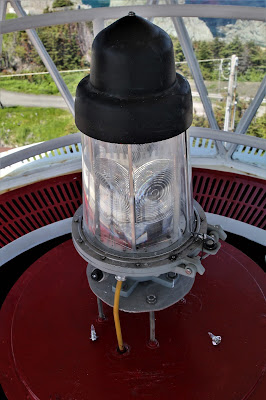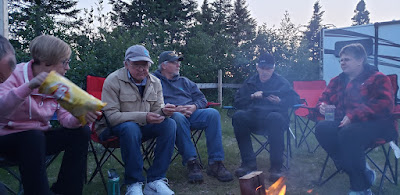The shower house at this campground was the best so far, I wish we could take it with us. Each one has its own toilet, sink, and shower.
Once we left camp, John, Ron, Dave, and Lionel went to the Wooden Boat Building Museum.
The remainder of us went to take a tour and tasting at the Auk Winery.
All the wines are made from native berries and fruits, no grapes are used, as they don't grow grapes in Newfoundland. The berries are picked by hand by local residents and made into wine. Some of the berries used include blueberries, partridgeberries, bakeapples, raspberries and crow-berries, just to name a few. Partridgeberries or Lingonberries are also popular as a wild picked fruit in Newfoundland and Labrador, where they are locally known as partridgeberries.
Auk Island Winery is located in the former Durrell’s Academy in Durrell’s Arm, South Twillingate Island. It was built in 1952, it closed in 1991. The owner of the winery actually went to school in this building when he was a kid.
We started out the tour with a talk about berries and harvesting icebergs.
We continued downstairs to the room where the wine gets made and bottled.
This is the press that is used to separate the skins from the juice.
After crushing and pressing, fermentation comes into play. Must (or juice) can begin fermenting naturally within 6-12 hours when aided with wild yeasts in the air.
Once fermentation is complete, clarification begins. Clarification is the process in which solids such as dead yeast cells, tannins, and proteins are removed. Wine is transferred or “racked” into a different vessel. Wine can then be clarified through fining or filtration.
Fining occurs when substances are added to the wine to clarify it. For example, a wine maker might add a substance such as clay that the unwanted particles will adhere to. This will force them to the bottom of the tank. Filtration occurs by using a filter to capture the larger particles in the wine. The clarified wine is then racked into another vessel and prepared for bottling or future aging. Aging and bottling is the final stage of the wine making process. A wine maker has two options: bottle the wine right away or give the wine additional aging.Further aging can be done in plastic barrels. Aging the wine will produce a smoother, rounder, and flavored wine. It also increases wine’s exposure to oxygen while it ages, which decreases tannin and helps the wine reach its optimal fruitiness.
This machine pours the wine into the bottles.
This is the bottling and labeling machine.
Bottle capping and labeling machine is the end of the process before they are boxed for shipping.
Many bottles of wine were purchased after the wine tasting.
After we finished, we met back up with the guys in the parking lot. We decided to head out to see the most photographed lighthouse in Newfoundland, the Longpoint Lighthouse. On the way there, of course we took photos out of the window while we were driving.
John and I took the tour and climbed to the top of the lighthouse. The views from there were spectacular.
Those are light bulbs for the spotlight on the red base.





























































































